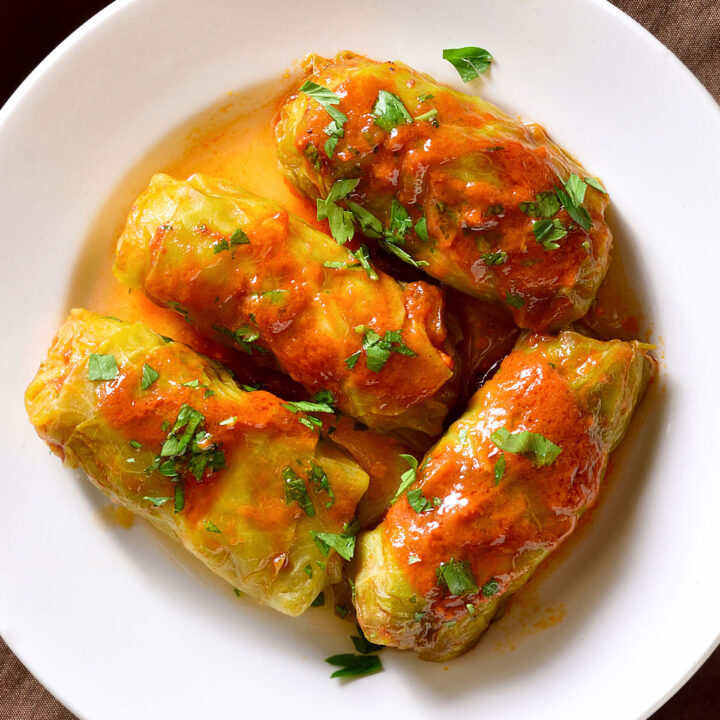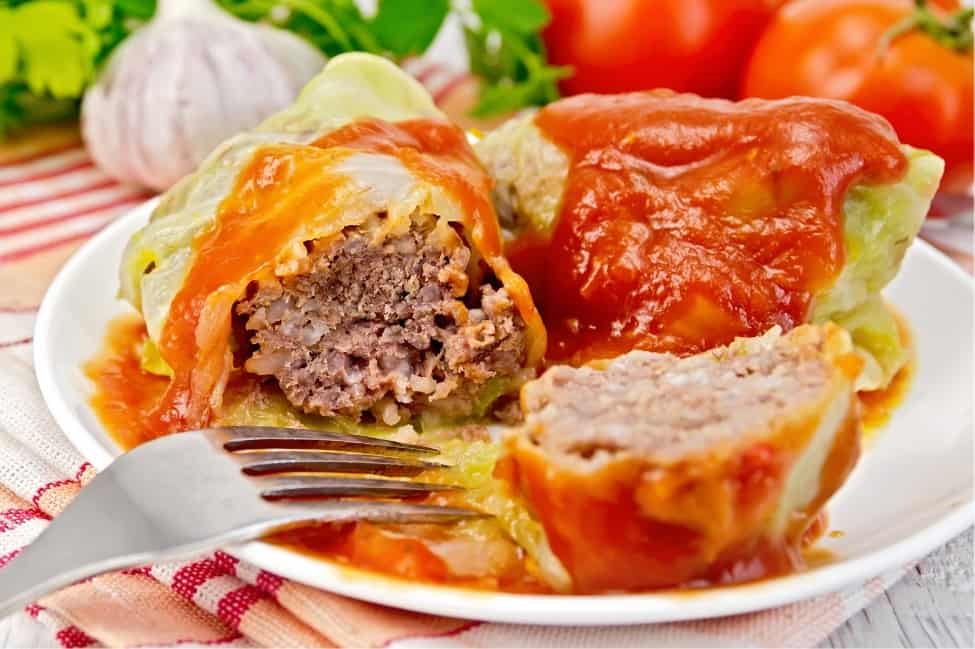Embark on a culinary adventure as we delve into the delectable world of golabki, a dish that has tantalized taste buds across generations. From its humble origins to its present-day variations, golabki has left an indelible mark on culinary history, weaving a tapestry of flavors that transcends time and culture.
In this comprehensive guide, we will explore the secrets behind crafting this beloved dish, uncovering the traditional ingredients, regional variations, and cultural significance that make golabki a culinary masterpiece.
Ingredients and their Benefits
Traditional golabki is a hearty and flavorful dish made with a variety of ingredients, each of which contributes to its unique taste and nutritional value.
Meat
The meat filling typically consists of ground beef, pork, or a combination of both. Meat is a rich source of protein, iron, and B vitamins, which are essential for muscle growth, red blood cell production, and energy metabolism.
Cabbage Leaves
Cabbage leaves are used to wrap the filling. They are a good source of fiber, vitamin C, and antioxidants, which support digestive health, immune function, and protect against cell damage.
Rice
Rice is often added to the filling to provide texture and carbohydrates. It is a good source of energy, fiber, and B vitamins, which are important for cell function and metabolism.
Onion and Garlic
Onion and garlic are added for flavor and aroma. They are also rich in antioxidants and anti-inflammatory compounds, which have been linked to improved heart health and reduced risk of chronic diseases.
Tomatoes
Tomatoes are used in the sauce that is poured over the golabki. They are a good source of vitamin C, lycopene, and antioxidants, which support immune function, heart health, and protect against cancer.
Overall, golabki is a nutrient-rich dish that provides a good balance of protein, carbohydrates, fiber, vitamins, and minerals. Consuming golabki can contribute to a healthy diet and provide numerous health benefits.
Step-by-Step Cooking s
Preparing golabki involves several key steps. Follow these instructions carefully to ensure delicious and well-crafted golabki.
Preparing the Cabbage Leaves
Remove the outer leaves of the cabbage and set them aside for later use. Bring a large pot of salted water to a boil. Carefully submerge the cabbage in the boiling water for 2-3 minutes, or until the leaves become pliable.
Stuffing the Cabbage Leaves
Remove the cabbage from the boiling water and let it cool slightly. Carefully separate the leaves from the head of the cabbage. Lay a cabbage leaf flat on a work surface and spread a portion of the filling in the center.
Rolling the Golabki
Fold the sides of the cabbage leaf over the filling, then roll the leaf up tightly. Tuck in the ends to secure the golabki.
Cooking the Golabki
Place the golabki in a large pot or Dutch oven. Add the remaining filling and enough liquid to cover the golabki by about an inch. Bring to a boil, then reduce heat and simmer for 1-2 hours, or until the cabbage is tender and the filling is cooked through.
Variations and Regional Differences
Golabki is a versatile dish that varies widely across regions, reflecting the diverse culinary traditions and cultural influences in different parts of the world.
Regional variations of golabki often involve unique combinations of ingredients and cooking techniques. For instance, in Poland, golabki are typically filled with a mixture of ground pork, beef, or lamb, while in Ukraine, they are often filled with a combination of pork and buckwheat.
In some regions, golabki are simmered in a tomato-based sauce, while in others, they are baked in a sour cream sauce.
Unique Golabki Recipes from Different Cultures
Here are a few examples of unique golabki recipes from different cultures:
- Polish Golabki: These golabki are made with a filling of ground pork, beef, or lamb, and are simmered in a tomato-based sauce.
- Ukrainian Golabki: These golabki are made with a filling of pork and buckwheat, and are simmered in a sour cream sauce.
- Lithuanian Golabki: These golabki are made with a filling of ground beef, pork, and rice, and are simmered in a mushroom-based sauce.
- Romanian Sarmale: These golabki are made with a filling of ground pork, beef, or lamb, and are wrapped in cabbage leaves that have been fermented in a brine solution.
- Turkish Sarma: These golabki are made with a filling of ground lamb or beef, and are wrapped in grape leaves.
Serving and Presentation

Golabki is a hearty and versatile dish that can be enjoyed in various ways. Traditionally, golabki is served hot, drizzled with a generous amount of sour cream or a tomato-based sauce. To enhance the presentation, sprinkle chopped fresh parsley or dill over the golabki for a vibrant touch.
Creative Presentation Techniques
- Arrange the golabki in a circular pattern on a large platter, resembling a wreath.
- Create a “bed” of mashed potatoes or roasted vegetables, and nestle the golabki on top for a cozy and visually appealing presentation.
- Skewer the golabki onto toothpicks or small wooden skewers and serve them as bite-sized appetizers.
Side Dishes and Accompaniments
Golabki pairs well with a variety of side dishes. Consider the following options:
- Sourdough bread or rye bread: These breads provide a perfect accompaniment to soak up the flavorful juices from the golabki.
- Potato salad or coleslaw: These classic side dishes add a refreshing contrast to the richness of the golabki.
- Roasted vegetables: Roasted carrots, parsnips, or beets bring a colorful and nutritious element to the meal.
Nutritional Value and Health Implications
Golabki is a nutrient-rich dish that provides an array of essential vitamins, minerals, and antioxidants. The combination of cabbage, meat, rice, and vegetables offers a balanced profile of macronutrients and micronutrients.
Nutritional Benefits
- Rich in fiber: The cabbage leaves and rice provide dietary fiber, which supports digestive health, promotes satiety, and helps regulate blood sugar levels.
- Excellent source of vitamin C: Cabbage is a great source of vitamin C, an antioxidant that boosts the immune system and protects cells from damage.
- Contains antioxidants: The vegetables and spices used in golabki, such as onions, carrots, and parsley, contain antioxidants that help protect against oxidative stress and reduce the risk of chronic diseases.
- Good source of protein: The meat filling provides a substantial amount of protein, which is essential for building and repairing tissues, and maintaining muscle mass.
- Contains iron: The meat and cabbage are good sources of iron, a mineral that is essential for carrying oxygen throughout the body.
Health Implications
While golabki is a nutritious dish, it is important to consider its potential health implications:
- High in sodium: Golabki can be high in sodium due to the use of salt in the meat filling and the addition of salt to the cooking water. Excessive sodium intake can increase blood pressure and the risk of cardiovascular disease.
- May be high in saturated fat: Depending on the type of meat used, golabki can be high in saturated fat, which can increase the risk of heart disease. Choosing lean meats and limiting the amount of added fat can help reduce saturated fat content.
- May cause digestive issues: The cabbage in golabki can be difficult to digest for some people, leading to gas, bloating, or constipation. Cooking the cabbage thoroughly and eating it in moderation can help reduce these symptoms.
Recommendations for Healthy Preparation
To make golabki a healthier choice, consider the following recommendations:
- Choose lean meats: Opt for lean meats, such as ground turkey or chicken, to reduce saturated fat content.
- Limit added salt: Reduce the amount of salt added to the meat filling and the cooking water to lower sodium intake.
- Use brown rice: Substitute white rice with brown rice for added fiber and nutrients.
- Add more vegetables: Include a variety of vegetables in the filling, such as bell peppers, mushrooms, or spinach, to increase nutrient content.
- Cook thoroughly: Cook the cabbage leaves thoroughly to make them easier to digest.
By following these recommendations, you can enjoy the delicious and nutritious benefits of golabki while minimizing potential health risks.
Cultural Significance and History

Golabki holds a special place in the culinary traditions of various cultures worldwide. It symbolizes comfort, warmth, and family gatherings.
Origins and Evolution
The origins of golabki can be traced back to ancient Slavic and Eastern European cultures. The dish is believed to have evolved from a simple filling of minced meat wrapped in cabbage leaves, often prepared during festivals and special occasions.
Over time, regional variations emerged, incorporating local ingredients and cooking techniques.
Cultural Impact
In Poland, golabki is a beloved dish served during Christmas and Easter celebrations. It represents the unity and warmth of family and friends coming together. In Ukraine, golabki is known as “holubtsi” and is a staple of traditional cuisine, often accompanied by a side of sour cream or dill sauce.
In Hungary, “töltött káposzta” is a popular comfort food enjoyed in winter months.
Summary
As we conclude our exploration of golabki, let us remember that it is more than just a dish; it is a testament to the power of culinary traditions and the enduring bonds that food creates. Whether enjoyed as a family meal or shared with friends, golabki embodies the spirit of hospitality and warmth that makes dining an unforgettable experience.
Frequently Asked Questions
What is the origin of golabki?
Golabki traces its roots back to Central and Eastern Europe, with variations found in Polish, Ukrainian, Lithuanian, and Belarusian cuisines.
What are the key ingredients in golabki?
Cabbage leaves, ground meat, rice, and onions form the core ingredients of golabki, while additional ingredients like mushrooms, sauerkraut, and spices vary depending on regional traditions.
How do you cook golabki?
Golabki can be cooked in various ways, including boiling, baking, or steaming. The cabbage leaves are first blanched to soften them, then filled with the meat and rice mixture before being rolled and cooked in a flavorful broth.
What are some regional variations of golabki?
Regional variations of golabki abound, with different cultures adding their own unique touches. In Poland, golabki are often filled with a mixture of pork and beef, while in Ukraine, they may include sauerkraut or mushrooms.
What are the nutritional benefits of golabki?
Golabki is a nutritious dish that provides a good source of protein, carbohydrates, and fiber. The cabbage leaves are rich in vitamins and minerals, while the meat and rice provide essential amino acids.
